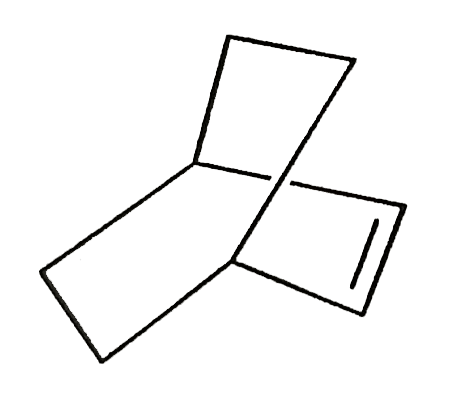Choose the correct code by identifying (X), (Y) and (Z) in each case for the changes indicated:
(i) CrO2Cl2KOH−−→(X)conc. H2SO4−−−−−−−−→(Y)AgNO3−−−→(Z)
(ii) CrCl3(aq)excess−−−→NaOH(X)Na2O2−−−−−−→H2O, boil(Y)lead−−−→acetate(Z)
(iii) ZnSO4(aq)Na2CO3−−−−→(X)Δ−−→(Y)cobalt−−−−−−→nitrate, Δ(Z)
(iv) CuCl2(aq)NH4OH−−−−→H2S(X)HNO3−−−→Δ(Y)KCN−−→excess(Z)
X=K2CrO4 Y=K2Cr2O7 Z=Ag2CrO4
X=[Cr(OH)4]− Y=Na2CrO4 Z=PbCrO4
X=ZnCO3 Y=ZnO Z=CoZnO2
X=CuS Y=Cu(NO3)2 Z=K3[Cu(CN)4]
The correct Answer is:D
To solve the given question, we will analyze each reaction step by step to identify the compounds (X), (Y), and (Z).
(i) Reaction: CrO2Cl2+KOH→(X)→(Y)→(Z)
1. Step 1: When CrO2Cl2 is treated with KOH, it forms K2CrO4.
- Identified as (X): K2CrO4
2. Step 2: When K2CrO4 is treated with concentrated H2SO4, it forms K2Cr2O7.
- Identified as (Y): K2Cr2O7
3. Step 3: When K2Cr2O7 is treated with AgNO3, it forms Ag2Cr2O7.
- Identified as (Z): Ag2Cr2O7
(ii) Reaction: CrCl3(aq)+NaOH(excess)→(X)→(Y)→(Z)
1. Step 1: When CrCl3 in aqueous solution is treated with excess NaOH, it forms NaCr(OH)4.
- Identified as (X): NaCr(OH)4
2. Step 2: When NaCr(OH)4 is boiled with water, it forms Na2CrO4.
- Identified as (Y): Na2CrO4
3. Step 3: When Na2CrO4 is treated with lead acetate, it does not form a precipitate in basic medium.
- Identified as (Z): No precipitate (not a specific compound)
(iii) Reaction: ZnSO4(aq)+Na2CO3→(X)→(Y)→(Z)
1. Step 1: When ZnSO4 in aqueous solution reacts with Na2CO3, it forms ZnCO3⋅3Zn(OH)2.
- Identified as (X): ZnCO3·3Zn(OH)2
2. Step 2: When ZnCO3⋅3Zn(OH)2 is boiled, it decomposes to form ZnO.
- Identified as (Y): ZnO
3. Step 3: When ZnO is treated with cobalt nitrate and heated, it forms CoZnO2.
- Identified as (Z): CoZnO2
(iv) Reaction: CuCl2(aq)+H2S→(X)→(Y)→(Z)
1. Step 1: When CuCl2 in aqueous solution is treated with H2S, it forms CuS.
- Identified as (X): CuS
2. Step 2: When CuS is treated with HNO3 and heated, it forms Cu(NO3)2.
- Identified as (Y): Cu(NO3)2
3. Step 3: When Cu(NO3)2 is treated with excess KCN, it forms K3(Cu(CN)4).
- Identified as (Z): K3(Cu(CN)4)
Summary of Identifications:
- (i) X = K2CrO4, Y = K2Cr2O7, Z = Ag2Cr2O7
- (ii) X = NaCr(OH)4, Y = Na2CrO4, Z = No precipitate
- (iii) X = ZnCO3·3Zn(OH)2, Y = ZnO, Z = CoZnO2
- (iv) X = CuS, Y = Cu(NO3)2, Z = K3(Cu(CN)4)
Final Answer:
The correct code by identifying (X), (Y), and (Z) in each case for the changes indicated is:
- (i) K2CrO4, K2Cr2O7, Ag2Cr2O7
- (ii) NaCr(OH)4, Na2CrO4, No precipitate
- (iii) ZnCO3·3Zn(OH)2, ZnO, CoZnO2
- (iv) CuS, Cu(NO3)2, K3(Cu(CN)4)
- Identified as (X): K2CrO4
- Identified as (Y): K2Cr2O7
- Identified as (Z): Ag2Cr2O7
- Identified as (X): NaCr(OH)4
- Identified as (Y): Na2CrO4
- Identified as (Z): No precipitate (not a specific compound)
- Identified as (X): ZnCO3·3Zn(OH)2
- Identified as (Y): ZnO
- Identified as (Z): CoZnO2
- Identified as (X): CuS
- Identified as (Y): Cu(NO3)2
- Identified as (Z): K3(Cu(CN)4)
- (i) X = K2CrO4, Y = K2Cr2O7, Z = Ag2Cr2O7
- (ii) X = NaCr(OH)4, Y = Na2CrO4, Z = No precipitate
- (iii) X = ZnCO3·3Zn(OH)2, Y = ZnO, Z = CoZnO2
- (iv) X = CuS, Y = Cu(NO3)2, Z = K3(Cu(CN)4)
The correct code by identifying (X), (Y), and (Z) in each case for the changes indicated is:
- (i) K2CrO4, K2Cr2O7, Ag2Cr2O7
- (ii) NaCr(OH)4, Na2CrO4, No precipitate
- (iii) ZnCO3·3Zn(OH)2, ZnO, CoZnO2
- (iv) CuS, Cu(NO3)2, K3(Cu(CN)4)
Topper's Solved these Questions
- QUALITATIVE INORGANIC ANALYSISBOOK - VK JAISWAL ENGLISHCHAPTER - QUALITATIVE INORGANIC ANALYSISEXERCISE - LEVEL 3
62 Videos
- QUALITATIVE INORGANIC ANALYSISBOOK - VK JAISWAL ENGLISHCHAPTER - QUALITATIVE INORGANIC ANALYSISEXERCISE - ONE OR MORE ANSWER IS/ARE CORRECT
43 Videos
- QUALITATIVE INORGANIC ANALYSISBOOK - VK JAISWAL ENGLISHCHAPTER - QUALITATIVE INORGANIC ANALYSISEXERCISE - SUBJECTIVE PROBLEMS
4 Videos
- PERIODIC PROPERTIESBOOK - VK JAISWAL ENGLISHCHAPTER - PERIODIC PROPERTIESEXERCISE - MATCH THE COLUMN
11 Videos
- s-BLOCK ELEMENTSBOOK - VK JAISWAL ENGLISHCHAPTER - s-BLOCK ELEMENTSEXERCISE - SUBJECTIVE PROBLEMS
2 Videos
Similar Questions
Knowledge Check
In the given reaction:
Ph−C∣∣O−CH3H2N−OH−−−−−−−−→H⊕(X)PCl5−−−−−→Δ(Y) Y will beAPh−C∣∣O−NH−CH3BH3C−O∣∣C−NH−PhCPh−CH2−O∣∣C−NH2DPh−CH2−CNSiCl4H2O−−→XHeat−−→YNaOH−−−→Z
find X,Y,Z.ASiO2SiNaSiBSi(OH)4SiO2Na2SiO3CSi(OH)4SiSiO2DSiO2SiCI4Na2SiO3What is compound Z ?
CH3CH2CH2BrNaCN−−−→XH3O+−−−→HeatYCH3CH2OH−−−−−−−→H+ZACH3CH=ChO∣∣COHBCH3CH2CH2CH=NOCH2CH3CCH3CH2CH2CH(OCH2CH3)2DCH3CH2CH2O∣∣COCH2CH3
 (i)O3−−−−−−−−→(ii)Zn−H2O¯:OH−−→Δ NO. of aldol condensation product.
(i)O3−−−−−−−−→(ii)Zn−H2O¯:OH−−→Δ NO. of aldol condensation product.
View Solutionp-Nitro phenol(X)(C2H5)2SO4/NaOH−−−−−−−−−−−−−→(1)Sn/HCl−−−−→(2)(Y)NaNO3/HCl−−−−−−−→(3)C6H5OH−−−−→(4) product is :
View SolutionIdentify (X), (Y) andc (Z) in the given reaction :
CH3CHOK2Cr2O7−−−−−→H2SO4(X)PCl5−−→(Y)C6H6−−−−−→anh.AlCl3(Z)
View SolutionPh−CH2−CH2CH3∣⊕N∣CH2CH2CH3−CH3ΘOH−−→Δ
View SolutionIn the given reactions:
(i). CH3BrNa,ether−−−−−→XBr2−−→hυYNa,etherZ
(ii) CH3COOHNaOH−−−→XNaOH−−−→CaOYBr2−−→hυZ
Identify, X,Y and Z
View Solution
